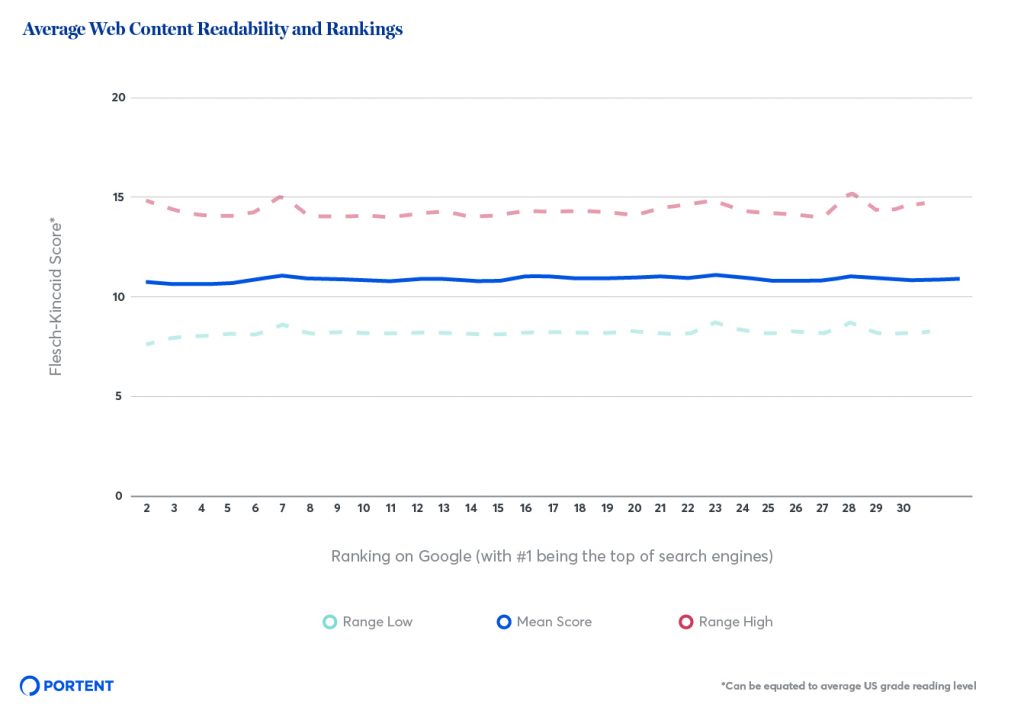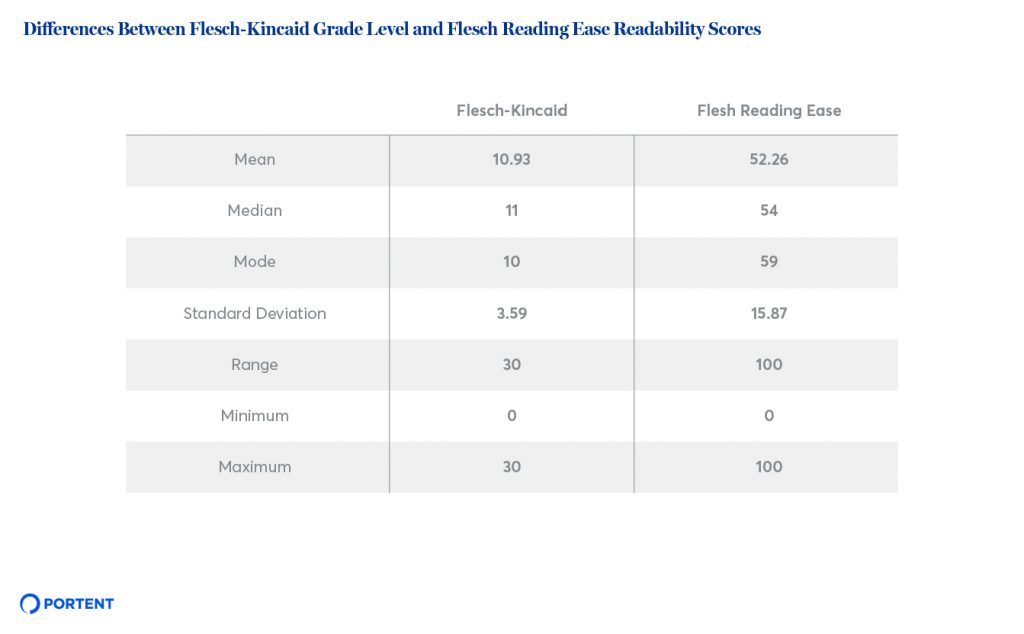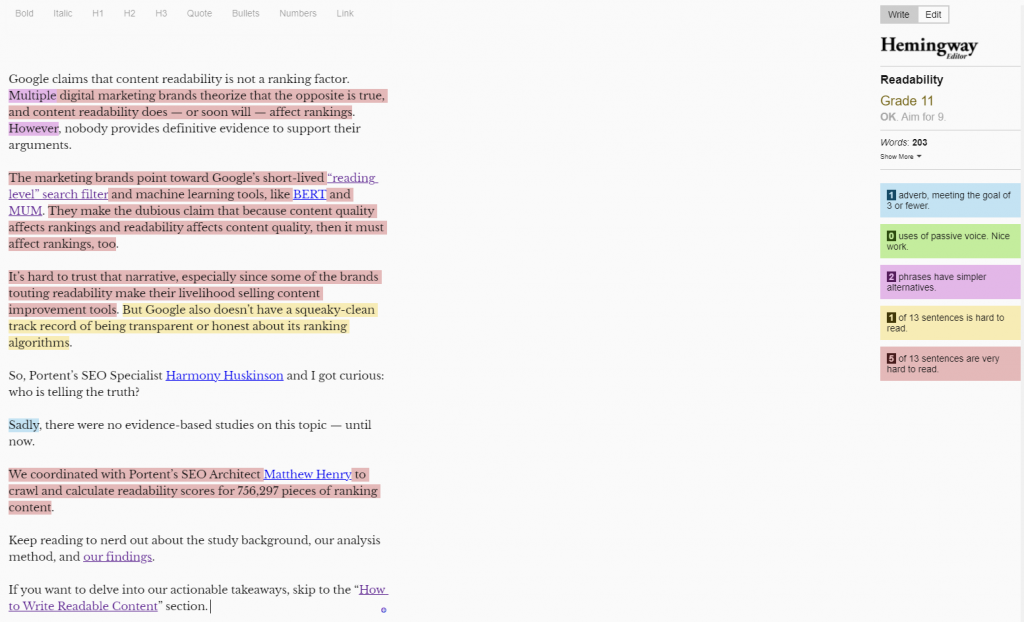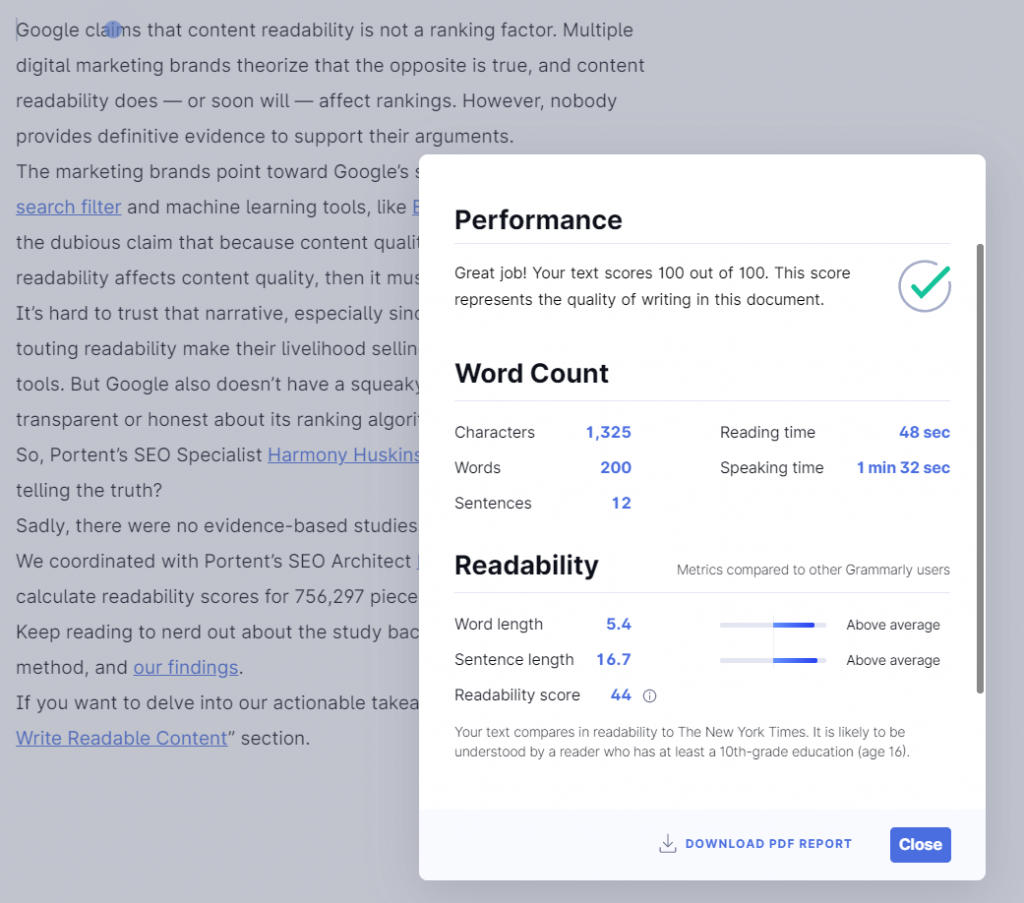Google claims that content readability is not a ranking factor. However, multiple digital marketing brands theorize that the opposite is true, and content readability does — or soon will — affect rankings. However, nobody provides definitive evidence to support their arguments.
The marketing brands point toward Google’s short-lived “reading level” search filter and machine learning tools, like BERT and MUM. They make the dubious claim that because content quality affects rankings and readability affects content quality, then it must affect rankings, too.
It’s hard to trust that narrative when the brands touting readability make their livelihood selling content improvement tools. But, how are we to know for sure? Google doesn’t have a squeaky-clean track record of transparency about its ranking algorithms.
So, Portent’s SEO Specialist Harmony Huskinson and I got curious: who is telling the truth? To our disappointment, there were no evidence-based studies on this topic—until now.
We coordinated with Portent’s SEO Architect Matthew Henry to crawl and calculate readability scores for 756,297 pieces of ranking content.
Keep reading to nerd out about the study background, our analysis method, and our findings. If you want to delve into our actionable takeaways, skip to the “How to Write Readable Content” section.
Study Background
Let’s ease into our analysis with a review of readability and the scoring system we used.
What is Readability?
Readability measures how easy or hard it is to understand text. Your text should be “readable” so users can easily understand your thoughts and ideas. Highly readable content also increases user engagement and decreases misinterpretation.
Multiple writing elements contribute to readability. The most common are:
- Word choice
- Average syllable length per word
- Sentence length
- Number of sentences
- Sentence structure
For example, if you describe the year 2020 and use the word “calamity” instead of “bad,” the reader must put forth more mental effort to read and understand the sentence, which makes the sentence more difficult to read for some audiences.
How is Readability Measured?
The well-recognized readability measurement systems for English are the Flesch Reading Ease (FRE), which evolved into the Flesch-Kincaid Grade Level (FKGL), and the National Assessment of Educational Progress Reading Scale.
The formulas for each readability system calculate readability differently, but they all represent roughly the same concept. Let’s break down the procedures for calculating readability with the FRE and FKGL, courtesy of Wikipedia.
Flesch Reading Ease Score Formula

FRE Score Interpretation
The result is a number between 0 and 100. Higher scores indicate the text is easy to read, while lower numbers identify more complex text to read.
| Score | School Level (US) | Notes |
|---|---|---|
| 100.00–90.00 | 5th grade | Very easy to read. Easily understood by an average 11-year-old student. |
| 90.0–80.0 | 6th grade | Easy to read. Conversational English for consumers. |
| 80.0–70.0 | 7th grade | Fairly easy to read. |
| 70.0–60.0 | 8th & 9th grade | Plain English. Easily understood by 13- to 15-year-old students. |
| 60.0–50.0 | 10th to 12th grade | Fairly difficult to read. |
| 50.0–30.0 | College | Difficult to read. |
| 30.0–10.0 | College graduate | Very difficult to read. Best understood by university graduates |
| 10.0–0.0 | Professional | Extremely difficult to read. Best understood by university graduates. |
The FKGL system builds on the concepts established in the FRE formula, but simplifies the output for educators and parents so they can more easily understand the reading level difficulty for a certain type of content.
Flesch-Kincaid Grade Level Formula

FKGL Score Interpretation
The result of the FKGL formula is a number between 0 and 18 that corresponds with a U.S. grade level, which indicates the years of schooling somebody needs to read and understand the text.
Our Readability Metric of Choice
We used the Flesch-Kincaid Grade Level score for our study. Compared to the FRE, the FKGL scale is easier to understand, used in common writing programs like Microsoft Word, and has accessible APIs to evaluate web page data.
Our Methodology
First, we determined a boilerplate approach for crawling content across tens of thousands of web pages. However, due to technical limitations, our crawler couldn’t accurately identify the core content of every page we crawled. In the first iteration of the test, our scrapes came back with extra, unnecessary content like navigations and footers.
To eliminate this discrepancy, our scraper ignored all anchor text. This choice let us disregard irrelevant content, but it also omitted any hyperlinked copy on a webpage. Although we had to compromise, we tested multiple pages of linkless text vs. full text in readability graders, and the differences were negligible.
Our crawler also ignored any web pages that didn’t have scrapable content—usually they were heavy on HTML or javascript.
After the scraper completed its crawl, we ran the results through a Flesch-Kincaid Grade Level API that calculated the reading grade level for each web page.
Our initial test analyzed the reading grade level of 756,297 pieces of content for 30,000 desktop search queries. The pages were a mix of blog content, service page content, and dictionary entries. For each query, we scraped content from the first 30 organic results.
Study findings
In this study, we wanted to unearth evidence that shows whether readability scores affect organic rankings. Our hypothesis: If Google’s ranking algorithms prefer simpler content, then the top-ranking results will have a lower reading grade level.
Our study concludes that readability is not a direct ranking factor. There is no correlation between ranking on Google and reading level for the page. However, we were surprised to discover that online content averaged at the 11th-grade reading level for the top 30 positions.

This discovery is notable because 50% of adults in the US struggle to read at the ninth-grade level or greater, according to a 2017 study in association with the National Center for Education Statistics.
Because so many people read at a lower grade level, numerous content guidelines, copyediting tools, and marketing blogs recommend producing general-audience content at the eighth-grade reading level or below. I give my thoughts of how our findings affect these suggestions in the ‘Where I Stand on Readability” section.
Due Diligence: Expanding the Data
The evidence from our initial crawls gave an emphatic answer to our hypothesis: Google’s algorithms don’t care about readability.
That result got us curious if the different types of content we crawled may have skewed our data. So, we got back to work.
First, we wanted to discover if dictionary-related search results had any outlier effects on the study. We isolated search results from every dictionary or thesaurus domain from our database, which removed 17,927 results from our data.
The narrowed data set gave the same results: 11th-grade reading level and no correlation between rankings and reading level.
Our next thought: what if this trend falls off past position 30? To answer this question, we extended our crawl to scrape pages from the top 100 search results. In total, we evaluated 5,813,565 web pages. The average reading level scores remained steady at 11th grade.
Last, we took our entire data set and then ran it through the Flesch Reading Ease formula to see if the formula would provide different results.
The mean FRE scores for the top 30 ranking pages ranged from 51.8–53.1, which places the content squarely in the 10-12th grade reading level.
Ultimately, no matter how we ran the numbers, they returned the same resounding “no” as an answer to whether content’s readability impacts rankings. Repeated crawls with various metrics affirmed that most content in search results scores at the 11th-grade reading level.

How to Write Readable Content
Our findings around readability and rankings do not mean it’s time to throw readability in the trash, start writing all content at the 11th-grade level, or declare war on your content. Readable content still matters for that crucial, enigmatic element—your users.
Ultimately, you should write for people, not bots. So, to write readable content, you should follow three guidelines:
- Write in an active voice.
- Aim for a readability score that reflects your audience’s needs. If you write for a general audience, then write at an eighth-grade reading level.
- Evaluate your writing with readability tools.
Readability tools are the simplest way to improve your writing technique and target specific reading grade levels. Plus, lots of them are free. Here are our favorites.
Microsoft Word
If you write most of your content in Word, you can access both Flesch tests using the spelling and grammar check tool.
- Flesch-Kincaid Grade Level: this test rates U.S. school grade level. You should aim for a score of 7.0-8.0 for general audience content.
- Flesch Reading Ease: this test is rated on a 100-point scale. You should aim to score between 60 and 70. Avoid scoring below or above this range.
Hemingway Editor
The Hemmingway Editor gives readability scores by copying and pasting your text into the browser app. The tool highlights sentences based on the complexity level.
Here’s an example of the tool in action:

Grammarly
Grammarly is a browser-based app that double-checks your content’s spelling, grammar, tone and voice, and readability score. Unlike other editors, you can also set custom goals to receive actionable feedback about improving your content for your target audience.
Here’s an example of the tool in action:

Where I Stand on Readability
Despite readability not affecting organic search rankings, I believe that it’s still a crucial element of writing quality, user-friendly content. Here’s why:
- Easily read text increases user engagement rates by decreasing the user’s cognitive load.
- Less complex word choice and sentences are harder to misinterpret.
- Readability scores can keep a brand’s content consistent and user-focused.
- Readability affects conversion rates.
However, I don’t believe that targeting 8th-grade readers is always necessary. Your target audience, the type of content you write, and your available resources should dictate the content’s reading level.
For example, most of this article reads at a 10th-grade level.
Is that bad?
If you’re reading Portent’s blog about a data-driven marketing study, then you’re likely a college-educated marketer who understands my vernacular. If I simplified the writing, the article would be easier to understand. You gain benefits from that simplicity, but I’d have to be careful not to oversimplify parts of the study.
Simple writing is hard. As we can see from the data, few authors, myself included, naturally write at an eighth-grade reading level. Doing so requires considerable skill, effort, and editing resources. Plus, not all writers have the talent or resources to perfect writing simply.
So, are the benefits of writing at an eighth-grade reading level worth the required investment when the target audience will understand the content either way?
In this situation, I say no. However, if this story read at a college reading level, then the investment to simplify it would be absolutely worthwhile.
The key to readability is knowing when simple writing is needed and when it’s only nice to have.
Let’s say I wrote a blog post about summer fashion trends for an e-commerce clothing website. I should absolutely write for an 8th-grade level reader because the brand targets a broad audience.
Complex writing is a disservice to general audience readers. Often, this mismatch results in unneeded user friction, which ends in fewer conversions and less brand loyalty.
Wrap Up
With our study, we walk away with a few crucial takeaways:
- Readability doesn’t affect rankings.
- The content we studied was written at an 11th-grade reading level.
- Readability still matters for users.
Fundamentally, SEO is an industry with lots of buzzwords, upsells, and fancy software. Whether any of this chatter has any significance is at the core of its discourse. At Portent, we’re constantly questioning what really has a positive impact on the success of our clients, and our employees as well.
We hope that with this study, we can move past caring solely about what Google says is important and look at the big picture of making a better website for other human beings.









